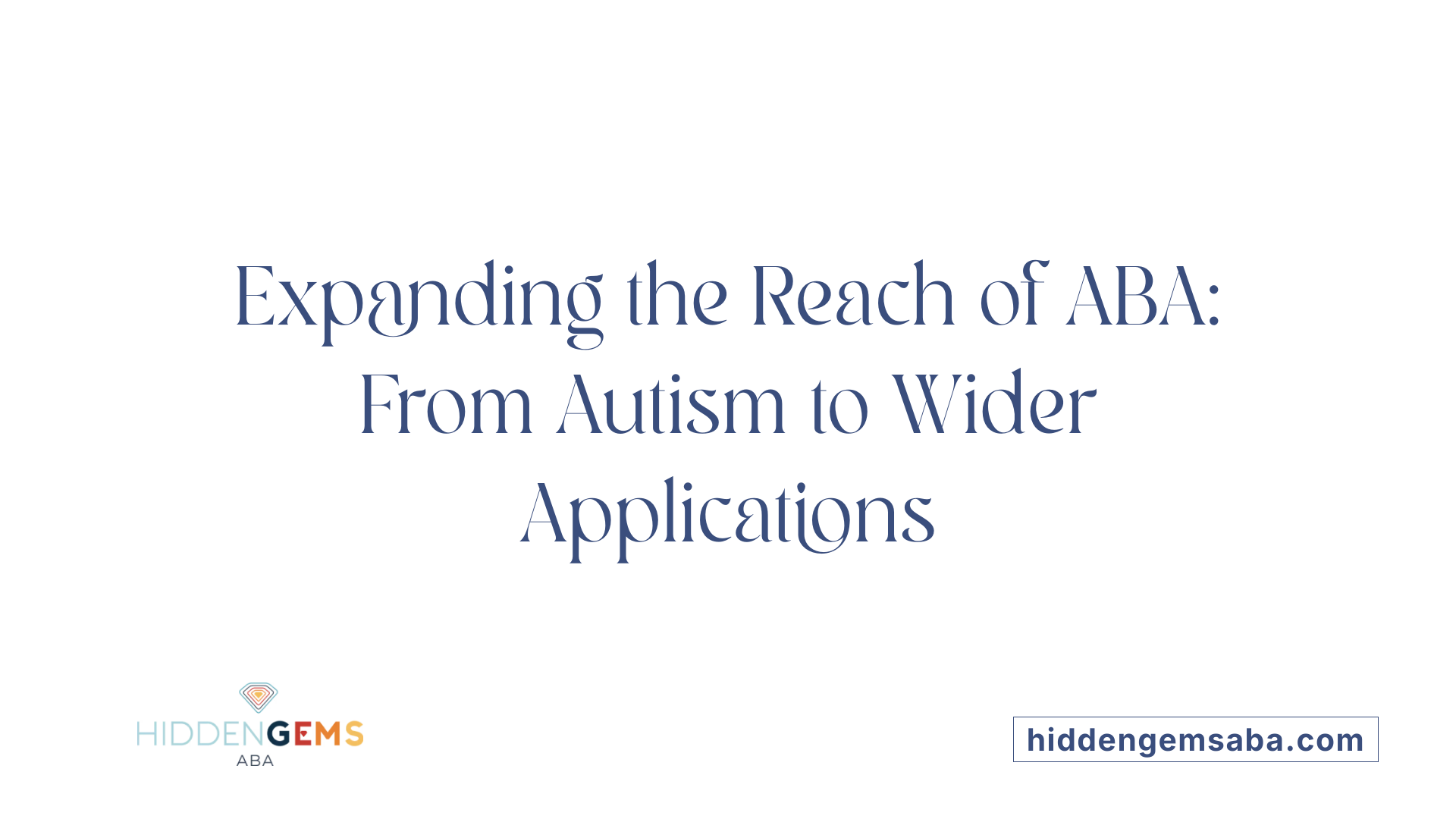A Comprehensive Overview of Behavioral Interventions for Children
Behavioral therapies play a crucial role in supporting children's developmental, social, and emotional growth, particularly for those with autism spectrum disorder (ASD). Among these, Applied Behavior Analysis (ABA) stands out as a scientifically validated, evidence-based approach. This article explores what ABA therapy and child behavioral therapy entail, their methods, benefits, scope, and how they can be integrated with other treatments to promote child wellbeing and development.
What is ABA Therapy and How Does It Differ from Other Behavioral Therapies?

Definition of ABA
Applied Behavior Analysis (ABA) is a scientific, evidence-based approach designed to understand and modify observable behaviors. It is especially focused on helping children with autism develop vital skills such as communication, socialization, and self-care. ABA employs techniques like positive reinforcement, systematic data collection, and individualized programs tailored to each person's needs.
Core principles of ABA
The foundation of ABA rests on several core principles. These include analyzing the antecedents (what happens before a behavior), the behavior itself, and the consequences that follow (known as the ABCs). Therapists identify the function or purpose of behaviors to develop appropriate interventions.
Techniques such as prompting (giving cues), shaping (reinforcing successive approximations), and token economies (using tokens as rewards) are commonly used. The goal is to increase helpful behaviors and reduce harmful ones by reinforcing desired actions and systematically modifying the environment.
Differences between ABA and other behavioral therapies like CBT
While ABA and Cognitive Behavioral Therapy (CBT) are both evidence-based, they have distinctive approaches and applications. CBT primarily targets thoughts and feelings, aiming to change emotional responses and cognition to influence behavior. It involves techniques like cognitive restructuring, exposure, and role-playing.
In contrast, ABA focuses directly on observable behaviors, using structured data collection and environmental modifications without necessarily addressing underlying emotional states or thoughts. ABA is more intensive and child-specific, often involving many hours of personalized therapy per week, especially for children with autism.
Although both therapies seek to improve functioning, ABA is particularly rooted in learning theory and behavioral science, making it highly quantitative and systematic in its approach. Not all behavioral therapists use ABA methods, as behavioral therapy can encompass various techniques; however, ABA remains the most researched and validated approach for developmental challenges like autism.
Applications of ABA Therapy for Children with Autism and Beyond

How is ABA therapy used for children with autism and beyond?
Applied Behavior Analysis (ABA) is a flexible and evidence-based approach primarily known for its success in helping children with autism spectrum disorder (ASD). It focuses on understanding how behaviors are influenced by the environment and how positive change can be achieved through targeted interventions.
For children with autism, ABA helps improve skills such as communication, social interaction, daily living, and self-care. It uses techniques like positive reinforcement, where children are rewarded for displaying desired behaviors, and task analysis, which breaks complex skills into manageable steps. This systematic approach encourages learning and independence in everyday activities.
Beyond autism, ABA's principles are widely applied to other conditions. For example, children with ADHD often benefit from reinforcement strategies to improve attention and task completion. Children with OCD or oppositional defiant behaviors may experience behavioral modifications through structured routines, prompting, and reinforcement methods.
It is also effective for children recovering from traumatic brain injuries (TBI), helping to regain cognitive and behavioral functions. The techniques used in ABA—such as self-monitoring and peer-mediated interventions—are adaptable to suit diverse needs and goals.
Outside clinical settings, ABA principles are harnessed in areas like organizational management, health promotion, and environmental conservation. These applications involve motivating positive behaviors, establishing routines, and encouraging sustainable habits.
Importantly, parental and caregiver involvement plays a vital role across all ABA interventions. Training families to reinforce skills at home ensures that behaviors are generalized across different environments, leading to more sustainable progress.
Overall, ABA's versatile, scientific approach continues to expand its reach. It offers tailored solutions for a wide array of developmental, psychological, and social challenges, emphasizing individual strengths and promoting full participation in society.
Core Methods and Techniques in ABA Therapy
What are the common methods and techniques used in ABA therapy?
ABA therapy utilizes a variety of strategies based on the science of learning and behavior. One of the most fundamental techniques is positive reinforcement, which involves rewarding desired behaviors with praise, tokens, or preferred items to encourage their recurrence.
Structured approaches like Discrete Trial Training (DTT) are also central to ABA. DTT breaks down skills into small, manageable steps and uses clear prompts followed by rewards or consequences to reinforce correct responses. This technique helps children learn new skills efficiently.
Modeling and prompting play important roles as well. Therapists demonstrate desired behaviors or skills, and may use visual cues or physical guidance to help children imitate actions. As competence increases, prompts are gradually faded to foster independence.
Behavior chaining and task analysis involve decomposing complex behaviors into smaller, sequential steps. This method ensures that children can learn entire routines by mastering each part individually, which promotes better skill retention and transfer.
In addition, natural environment teaching (NET) emphasizes learning in everyday settings, such as home or playground. This approach helps children apply learned skills in real-world contexts, making behaviors more functional and meaningful.
Together, these methods are tailored to the individual's needs, supporting the development of communication, social interaction, and daily living skills while reducing problematic behaviors. The use of systematic reinforcement, modeling, prompting, and environment-based learning embodies the evidence-based principles that underpin effective ABA interventions.
Addressing Challenging Behaviors with ABA

Does ABA therapy help with behavioral issues such as aggression?
Yes, ABA therapy is effective in helping individuals, especially children with autism, manage and reduce behaviors like aggression. It is rooted in understanding the function behind challenging behaviors through assessments such as functional behavior analysis. This process helps identify what triggers aggressive actions, whether it’s frustration, communication difficulties, or environmental factors.
Once the function of the behavior is understood, tailored strategies are developed to address those specific triggers. ABA employs various techniques, including teaching alternative communication methods like picture exchange systems or sign language, which help reduce the urge to act out aggressively due to communication frustrations.
Positive reinforcement plays a major role in this approach. Successful attempts to express needs or emotions are rewarded with preferred activities or items, encouraging the individual to adopt appropriate behaviors. Visual supports, calming techniques, and behavior replacement skills are also integrated into therapy to promote emotional regulation and reduce impulsivity.
Consistent application of these strategies, often involving caregivers, teachers, and trained professionals, can lead to significant improvements. Over time, individuals learn healthier ways to express their needs and cope with difficult emotions, resulting in decreased aggression and better social and emotional functioning.
Measuring Success in ABA: Outcomes and Progress
How are the progress and outcomes measured in ABA therapy?
In ABA therapy, tracking progress relies heavily on meticulous data collection. Therapists record details such as how often specific behaviors occur, skill acquisition levels, and responses to interventions during each session. This systematic approach provides a clear picture of whether the child is meeting developmental milestones or requires adjustments in their treatment plan.
Standardized assessments are also vital in measuring outcomes. Tools like the Verbal Behavior Milestones Assessment and Placement Program (VB-MAPP) and the Assessment of Basic Language and Learning Skills-Revised (ABLLS-R) evaluate a child's current skills and identify growth opportunities. These assessments are performed initially to establish a baseline and are repeated periodically to chart progress.
Progress monitoring involves analyzing the behavior data collected over time, observing behavioral improvements, and modifying goals as needed. Regular review meetings between therapists and caregivers help ensure that interventions remain aligned with the child's evolving needs. The combined use of detailed data tracking, standardized assessments, and caregiver insights provides a robust framework for measuring success and guiding ongoing ABA treatment.
Qualifications of ABA Therapists
What qualifications do ABA therapists typically have?
ABA therapists usually hold at least a master's degree in fields like Applied Behavior Analysis, Psychology, Education, or other related behavioral sciences. Many educational programs in these fields are accredited by organizations such as the Association for Behavior Analysis International (ABAI) or the Association of Professional Behavior Analysts (APBA), ensuring a quality curriculum focused on behavior analysis practices.
One of the most important qualifications is certification from the Behavior Analyst Certification Board (BACB). Most ABA therapists aim to become a Board-Certified Behavior Analyst (BCBA). To achieve this certification, candidates must complete specific coursework covering behavioral principles and intervention strategies, accumulate between 1,500 and 2,000 hours of supervised practical experience, and pass a comprehensive exam.
Certification alone is not all; licensing requirements can vary by state or country. In many places, ABA therapists must provide proof of their education, experience, and ongoing continuing education credits to maintain their certification and licensure.
In addition to formal education and certification, successful ABA therapists develop critical skills such as active listening, detailed observation, critical thinking, empathy, and adaptability. These skills enable them to create personalized treatment plans and modify strategies based on individual progress.
The pathway to becoming a qualified ABA therapist can take several years, involving university education, supervised practical training, certification examinations, and, where applicable, licensing or registration requirements. This comprehensive preparation helps ensure that ABA therapists are equipped to provide effective, evidence-based interventions tailored to each individual's needs.
The Broader Scope of ABA Beyond Autism
Use in other populations
While ABA is most well-known for its success in helping children with autism, its applications extend well beyond this population. The foundational principles of ABA—analyzing observable behaviors, understanding environmental influences, and using reinforcement strategies—are useful in various settings and for diverse groups. For example, ABA techniques have been applied to manage behavioral challenges in children with ADHD, anxiety disorders, and OCD. They are also used in developmental disabilities, helping individuals build essential life skills and improve daily functioning.
In educational contexts, ABA methods support children and adolescents in developing academic and social skills. Moreover, these strategies are employed in therapies for adults, especially those with mental health conditions, to promote behavioral change and enhance quality of life.
Applications in organizational and environmental areas
Beyond individual therapy, ABA principles are increasingly used in organizational management and environmental conservation. In the workplace, ABA techniques are adapted for staff training, improving productivity, and fostering positive work behaviors. Some organizations use reinforcement systems to motivate employees or improve safety compliance.
In environmental settings, behavior analysis helps in promoting sustainable behaviors—like recycling, conserving energy, or reducing waste—by analyzing triggers and reinforcing eco-friendly actions. These applications demonstrate ABA’s versatility in influencing behaviors across various societal sectors.
| Application Area | Focus | Description |
|---|---|---|
| Clinical Populations | Autism, ADHD, Anxiety, OCD, Developmental Disabilities | Changing behaviors and building skills across lifespan |
| Education | Skill development, socialization | Implementing learning strategies and positive reinforcement |
| Organizational Management | Employee behavior, productivity | Training, motivation, safety reinforcement |
| Environmental Conservation | Promoting eco-friendly behaviors | Recycling, energy saving, waste reduction |
Is ABA therapy only applicable to individuals with autism?
ABA is not limited to individuals with autism. Its scientific approach to understanding behavior makes it applicable across a broad scope of needs and settings. Its use in managing behaviors related to developmental disabilities, mental health issues, organizational efficiency, and environmental sustainability illustrates its expanding reach. Tailored interventions based on ABA principles can improve lives in many contexts, promoting positive change for diverse populations.
Qualifications of ABA Therapists and Ethical Considerations

What qualifications do ABA therapists typically have?
ABA therapists usually possess at least a master's degree in fields such as Applied Behavior Analysis, Psychology, Education, or related behavioral sciences. Many of these programs are accredited by reputable organizations like the Association for Behavior Analysis International (ABAI) or the Association of Professional Behavior Analysts (APBA).
To practice professionally, they must obtain certification from the Behavior Analyst Certification Board (BACB), most commonly as a Board-Certified Behavior Analyst (BCBA). Achieving this certification involves completing specific coursework aligned with BACB standards, accumulating between 1,500 and 2,000 hours of supervised practical experience, and passing a comprehensive exam.
Licensing requirements can vary by state but generally include proof of relevant education, successful certification, and ongoing continuing education credits to maintain licensure and certification.
Beyond formal qualifications, effective ABA therapists demonstrate skills such as active listening, keen observation, critical thinking, empathy, and adaptability. Their training process encompasses several years, including education, supervised practical experience, certification, and, where applicable, licensure. These rigorous standards ensure that ABA practitioners are well-prepared to support individuals through evidence-based and ethically sound interventions.
The Future of Behavioral Interventions in Child Development
As research continues to validate ABA therapy and expand its applications, the importance of ethical, individualized, and evidence-based interventions remains paramount. With ongoing innovations and a growing understanding of diverse needs, behavioral therapies are poised to play a vital role in supporting children and families, fostering independence, and enhancing quality of life well into the future.
References
- Applied Behavior Analysis (ABA) | Autism Speaks
- The Controversy Around ABA - Child Mind Institute
- Applied Behavior Analysis (ABA) - Children's Health
- Applied Behavior Analysis in Children and Youth with Autism ...
- Behavioral Therapy for Autism Spectrum Disorder in Children
- ABA Therapy vs CBT for Autism: Which is Better?
- Applied Behavior Analysis: What Is It and How Does It Work? - WebMD
- Applied Behavior Analysis - Psychology Today





